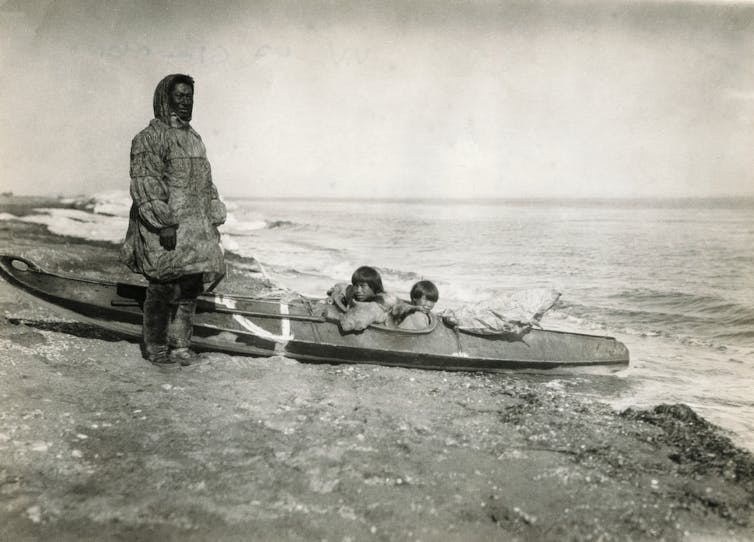Collecting water and caring for kids are daily necessities.
Cara Wall-Scheffler, University of Washington
Think about taking a walk: where you need to go, how fast you need to move to get there, and whether you need to bring something along to carry the results of your errand.
Are you going on this walk with someone else? Does walking with a friend change your preparation? If you’re walking with a child, do you remember to bring an extra sweater or a snack? You probably did – because people intuitively vary their plan depending on their current needs and situations.
In my research as an anthropologist, I’ve focused on the evolution of human walking and running because I love the flexibility people bring to these behaviors. Humans in all kinds of environments across space and time vary how far they go, when they go and what they go for – whether food, water or friends – based on a multitude of factors, including season, daylight, rituals and family.
Anthropologists split their studies of human activity into two broad categories: what people need to do – including eat, keep their kids alive and so on – and what solutions they come up with to accomplish these needs.
How people keep their children alive is a key issue in my research because it has a direct impact on whether a population survives. It turns out that kids stay alive if they’re with adults. To this end, it is a human universal that women carry heavy loads every day, including kids and their food. This needs-based behavior seems to have been an important part of our evolutionary history and explains quite a few aspects of human physiology and female morphology, such as women’s lower center of mass.
Women are built for endurance. What needs-based behaviors drove this evolutionary path?
The solutions to other key problems, like specifically which food women will be carrying, vary across time and space. I suggest that these variations are as integral to explaining human biology and culture as the needs themselves.
Impacts of uncommon activities
Evolutionary scientists often focus on how beneficial heritable traits get passed on to offspring when they provide a survival advantage. Eventually a trait can become more common in a population when it provides a useful solution.
For example, researchers have made big claims about how influential persistence hunting via endurance running has been on the way the human body evolved. This theory suggests that taking down prey by running them to exhaustion has led to humans’ own abilities to run long distances – by increasing humans’ ability to sweat, strengthening our head support and making sure our lower limbs are light and elastic.
But persistence hunting occurs in fewer than 2% of the recorded instances of hunting in one major ethnographic database, making it an extremely rare solution to the need to find food. Could such a rare and unusual form of locomotion have had a strong enough impact to select for the suite of adaptive traits that make humans such excellent endurance athletes today?
Maybe persistence hunting is actually a fallback strategy, providing a solution only at key moments when survivorship is on the edge. Or maybe these capabilities are just side effects of the loaded walking done every day. I think a better argument is that the ability to predict how to move between common and uncommon strategies has been the driver of human endurance capacity.
Hunting big game is only one way to get food – this Inuit man and children are heading out to find eggs.
Everyday life’s influence on evolution
Hunting itself, especially of large mammals, is hardly ubiquitous, despite how frequently it is discussed. For example, anthropologists tend to generalize that people who lived in the Arctic even up to a hundred years ago consumed only animal meat hunted by men. But actually, the original ethnographic work reveals a far more nuanced picture.
Women and children were actively involved in hunting, and it was a strongly seasonal activity. Coastal fishing, berry picking and the use of plant materials were all vital to Arctic people’s day-to-day sustenance. Small family groups used canoes for coastal foraging for part of the year.
During other seasons, the whole community participated in hunting large mammals by herding them into dangerous situations where they were more easily killed. Sometimes family groups were together, and sometimes large communities were together. Sometimes women hunted with rifles, and sometimes children ran after caribou.
The dynamic nature of daily life means that the relatively uncommon activity of hunting large terrestrial vertebrates is unlikely to be the main behavior that helps humans solve the key problems of food, water and keeping children alive.
Anthropologist Rebecca Bliege Bird has investigated how predictable food is throughout the day and the year. She’s noted that for most communities, big game is rarely caught, especially when a person is hunting alone. Even among the Hadza in Tanzania, generally considered a big-game hunting community, a hunter acquires 0.03 prey per day on average – essentially 11 animals a year for that person.
Bird and others clearly argue that the planning and flexible coordination done by females is the crucial aspect of how humans survive on a daily basis. It’s the daily efforts of females that allow people to be spontaneous a few times a year to accomplish high-risk activities such as hunting – persistence or otherwise. Therefore it is female flexibility that allows communities to survive between the rare big-game opportunities.
Changing roles and contributions
Some anthropologists argue that in some parts of the world, behavior varies more for cultural reasons, like what tools you make, than for environmental ones, such as how much daylight there is during winter. The importance of culture means that the solutions vary more than the needs.
One of the aspects of culture that varies is the role assigned to specific genders. Varying gender roles are related to the distribution of labor and when people take on certain solution-based tasks. In most cultures, these roles change across a female’s life span. In American culture, this would be like a grandparent going back to college to hone a childhood passion in order to take on a new job to send their grandchildren to college.
In many places, females go from youth when they might carry their siblings and firewood, to early parenthood where they might go hunting with a baby on their back, to older parenthood where they might carry water on their head, a baby on their back and tools in their hands, to postmenopausal periods when they might carry giant loads of mangoes and firewood to and from camp.
Even though always load carrying, our capacity to plan and change our behavior for diverse environments is part of what drives Homo sapiens’ success, which means that the behavior of females across their different life stages has been a major driver of this capability.![]()
Cara Wall-Scheffler, Professor and Chair of Biology at Seattle Pacific University and Affiliate Assistant Professor of Anthropology, University of Washington
This article is republished from The Conversation under a Creative Commons license. Read the original article.

























































